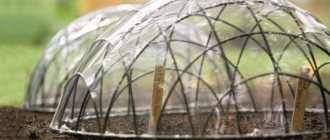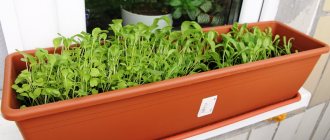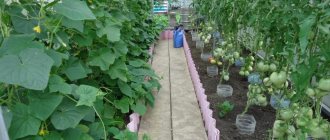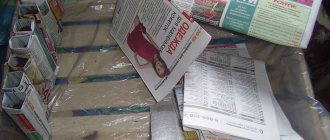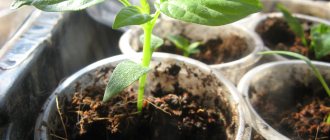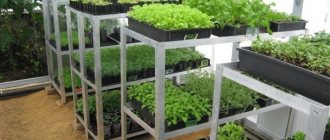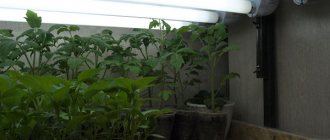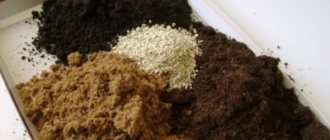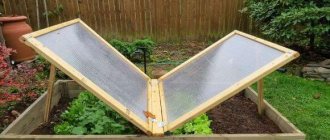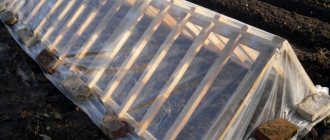The right soil for seedlings is the beginning. Young seedlings receive the necessary nutrition from the ground. Their health and your future harvest depend on this. But the “tastes” of different crops differ, and this should be taken into account when preparing the soil.
What should the ideal soil be like? Let's figure it out.
For seed germination, two main conditions are required: optimal temperature and humidity. That is, the soil should absorb moisture well and retain moisture for a long time, but at the same time provide enough air so that the seed does not rot. In addition, in dense soil it will be difficult for young roots to germinate, which means the soil should be light and loose.
With a small volume of soil in which the seedlings develop and a fairly high sowing density, a sufficient amount of nutrients is necessary to ensure the growth and development of seedlings.
The “correct” acidity of the soil is also important - if the pH balance is disturbed, plants will not be able to fully absorb some macroelements, and their growth will slow down. For most crops, neutral acidity is optimal - pH 6.5-7.
Last but not least, the soil must be free of pathogens: weeds, fungal spores, pathogenic bacteria, pests and their larvae.
What soil is best for growing seedlings?
So, what is the best soil for seedlings, and in what kind of soil should the seeds be sown?
In the literature devoted to the problems of vegetable growing, one can find many recommendations for preparing soil for growing seedlings; their composition depends on the biological characteristics of the crop, the period of its cultivation and on the available components. We should start talking about seeds with the fact that they, having a supply of nutrients, do not require fertile soil at first. They need water and air the most. To use them fully, the soil for seedlings must, first of all, be loose, porous, moisture-absorbing, air- and water-permeable. Then the seeds will germinate without any problems, throw out the cotyledons and be in excellent condition for picking.
Knowing what kind of soil is needed for seedlings, you can buy a soil mixture in a specialized store or prepare it yourself by combining the available ingredients - peat, humus, compost, sawdust, sand, etc. The composition depends on the crop and the funds available to the gardener. Listening to the advice of experts, however, try to create your own recipe for the best soil for seedlings, based on your own capabilities. The only thing that everyone agrees on is that you should not use damp garden soil for sowing seeds, soil from the area where cabbage and potatoes grew, and from flower beds due to the fact that the former is unsatisfactory in structure; in other cases, infection by pests and spores is possible fungi and pathogenic microorganisms.
Speaking about which soil is best for seedlings, most gardeners recognize the following mixtures as optimal for sowing seeds:
- compost, garden soil and coarse sand (1:1:1);
- humus, turf soil and sand (2:1:1);
- humus and sand (1:1).
These are the best soil options for seedlings, which are suitable for crops intended for picking at the stage of formation of cotyledons or 1-2 true leaves.
By the time of transplanting the seedlings, it is necessary to prepare the seedling boxes and fill them with soil. Compared to seed soil mixture, it should be more nutritious (all other qualities should also be present), especially since the plants will remain in it until planting in indoor or open ground. This does not mean that you can immediately fill the soil with minerals and forget about fertilizing. Remember that even the best soil for vegetable seedlings will only have enough nutrients for no more than 2 weeks.
Rating of the best soils for plants
| Nomination | place | Name of product | price for 10 liters |
| The best universal soils for plants | 1 | COMPO SANA universal soil soil | 210 ₽ |
| 2 | Terra Vita soil Living earth universal | 80 ₽ | |
| 3 | Soil Good helper universal | 50 ₽ | |
| The best soils for indoor plants | 1 | FASCO flower soil | 60 ₽ |
| 2 | Soil PETER PEAT Hobby line for indoor plants | 90 ₽ | |
| 3 | Veltorf universal soil for indoor flowers | 80 ₽ | |
| The best soils for vegetable crops | 1 | BIUD vegetable soil | 90 ₽ |
| 2 | Fasko Krepysh soil for seedlings | 60 ₽ | |
| 3 | Morris Green soil for growing vegetables | 90 ₽ | |
| The best soils for aquarium plants | 1 | Nutrient soil for aquarium Dennerle Deponitmix Professional 9 in 1 | 4 620 ₽ |
| 2 | Tetra ActiveSubstrate | 1 220 ₽ | |
| 3 | Nutrient soil JBL Manado improves water quality and stimulates plant growth | 1 250 ₽ |
Composition of the correct soil for seedlings in a greenhouse and at home
If you decide to make soil for seedlings with your own hands, then you need to take care of it in advance and prepare turf soil, humus, non-acidic peat, coarse river sand, lime (chalk, dolomite flour), wood ash, mineral fertilizers, sawdust, etc. Of course , not all of this necessarily needs to be included in the mix. From these components, you can choose what you have and make a soil mixture from them in the required quantity. For example, soil for seedlings at home from soil for seedlings in a greenhouse may differ in the quantitative content of manure (at home - less, in a greenhouse - more), because inhaling its vapors is an unpleasant task. Some components are interchangeable. For example, instead of humus or compost, you can use vermicompost (vermicompost).
So, we prepare the soil for seedlings ourselves, but first, check out some of the recipes that are most popular among gardeners. The composition of soil for seedlings can be as follows:
- peat, turf soil, humus (compost) and sawdust (coarse sand) (3:2:4:1);
- peat, compost and sawdust (3:5:1);
- humus, turf soil and coarse sand (2:2:1);
- turf soil and manure humus (1:1);
- peat, humus and sawdust (2:2:1);
- humus and peat (2: 2);
- turf soil, humus and mullein (3:6:1);
- peat, humus, turf soil and mullein (5:3:1:1).
In the soil for seedlings that you prepare yourself, add an additional 2 tablespoons per bucket of each mixture. wood ash and 1 tbsp. superphosphate.
Coconut substrate for seedlings
Gardeners have recently been willing to use home-made coconut substrate as seedling soil, which is environmentally friendly, consisting of 70% coconut fiber and 30% recycled coconut palm husk. For seedling soil, coconut substrate can be mixed with peat in a 1:1 ratio. If you do not include peat, you will have to periodically fertilize with a weak solution of fertilizers.
Using a coconut substrate, a favorable breathable environment is created for the formation of a powerful root system of seedlings. The coconut mixture gives clay soil looseness and increases the moisture capacity of sandy soil. This substrate can also be used as mulch, protecting the soil from overheating and drying out.
Seedling soil from coconut substrate is prepared according to the instructions on the package: 1 kilogram of substrate is designed for 15 liters of water.
To obtain, for example, 4 liters of soil, you need one and a half liters of warm water, where you should put a briquette of the substrate and give it 10-15 minutes to swell. After this time, the briquette will increase many times in volume and become loose and porous. It can be used as soil or included in seedling potting mix.
High-quality soil for seedlings: how to prepare the soil
Turf soil deserves a few words. This component is included in many mixtures of high-quality soil for seedlings, since it is nutritious (contains rotted remains of plant and animal origin), porous and retains moisture well, but is not prone to compaction and does not allow excess moisture to stagnate.
Before preparing the soil for seedlings, in order to get real turf soil, at the end of June it is necessary to cut layers of turf 20-30 cm wide and 8-12 cm thick (the length can be any) and lay them in a stack (width and height - 1.2 -1.5 m). The bottom row consists of layers laid with grass up, manure should be placed on it and another row of turf with grass down. If the soil is wet, then it is enough to sprinkle the layers with phosphate rock (5 kg/m1) and lime (2-3 kg/m3), but if it is dry, then water it with water, or even better, slurry (this will speed up decomposition). Once all the sod has been laid, lift the edges of the stack to create a depression. It will retain liquid after moistening.
In the summer of next year, shovel the soil at least 2 times, and in the fall, sift through a sieve and pour into containers or paper bags. You cannot leave it in the open air, as it will quickly lose those qualities for which so much time and effort was spent on it. If you decide to prepare the soil for seedlings as best as possible, keep in mind that turf soil with the best properties is obtained after 2 seasons.
Peter Peat Universal
What we have:
- Nitrogen – 170 mg/l.
- Phosphorus – 160 mg/l.
- Potassium – 270 mg/l.
- pH – not less than 5.5.
- Humidity – no more than 65%.
It contains highland and lowland peat as a base. Among the advantages is the high content of humic substances. The name of some compositions is an acquired taste - “Zhirnozem”. In general, the consistency is homogeneous, there are almost no lumps. Sticks may appear, but rarely. Vegetable and flower crops do well in it.
Preparing the soil for planting seedlings: preparing the soil
When preparing soil for seedlings, in order to obtain crumbly dark-colored soil as a result of composting, you must follow some rules:
- In addition to organic substances that quickly decompose (manure, plant debris, etc.), the necessary components of compost are slowly decomposing sawdust, shavings, chopped stems, leaves and garden soil, and not in an arbitrary, but in a strictly defined ratio - 1: 1: 0 ,5.
- Place compostable materials in layers, the last of which should be soil. If this requirement is not met, plant residues are compressed and begin to prevent oxygen from penetrating deep into the stack.
- When laying compost, moisten the layers and sprinkle them with lime. The ripening of compost is accelerated by watering with slurry, but waterlogging and drying out are equally harmful to the compost.
- To ensure heating to 55-70° C, the compost pile must have sufficiently large dimensions - 1.5 x 1.5 x 1.5 m.
If the above conditions are met, the compost will mature in 5-7 months, during which it must be shoveled several times so that the process proceeds evenly, and in winter the pile must be covered with dry leaves. When the compost is ready, sift it. Use everything that is not sufficiently decomposed to lay the next pile, and add the fine fraction to the seedling soil mixture.
If you want to further verify whether the compost is ready for use, conduct the following test: prepare shallow containers, fill one of them with sand and the other with compost, moisten them and evenly distribute the watercress seeds over the surface, then place them in transparent plastic bags . When the seeds begin to germinate, compare their number and root length in both containers. If the result of seeds germinated on compost is worse, this means that it is not yet ripe.
The composition of the soil for sowing seeds for seedlings may also include peat. It is usually sold in specialized stores, but you can also check its quality. Do the same test as for compost, but replace the watercress with radishes.
If for some reason you have not prepared soil for seedlings, you can buy soil at the store. Such mixtures can be wet or dry. The latter are more profitable, since you yourself are able to add the required amount of water to them in order to get 6 liters of soil from a dry briquette weighing 750 g. There are mixtures specifically designed for individual crops - sweet peppers, eggplants, tomatoes (the difference is in the ratio of nitrogen, phosphorus and potassium), and universal ones. You can sow seeds in them and pick up seedlings. However, gardeners, especially beginners, should be careful. Recently, in the literature there have been unflattering reviews about the quality of purchased soil mixtures. They write that often a freshly opened bag smells of mold or ammonia (the first means that the pound is contaminated with mushrooms, and the second means that it contains a large amount of undecomposed organic matter), that often the soil contains harmful microorganisms, or is even depleted soil, thrown out of greenhouses. In this regard, it is recommended to buy soil from well-known manufacturers with a good reputation.
Geolia soil
Leroy Merlin stores sell Geolia primer. As I understand it, it is produced specifically for this network. The basis is peat with the addition of vermicompost. The consistency is uniform, without debris. Packaging – from 2 to 50 l.
The composition is not bad, but in terms of nutritional value some elements are at the lower standard (NH4 + NO3 and P2O5). In particular:
- Nitrogen (NH4+NO3) – not less than 150 mg/l.
- Phosphorus (P2O5) – not less than 150 mg/l.
- Potassium (K2O) – not less than 220 mg/l.
But there are many important microelements present - B, Mn, Zn, Cu, Co, Fe, Mo. Acidity is normal (from 5.5 to 7.0).
Many summer residents point to good germination, strong healthy seedlings. There are also those who claim as a disadvantage that the composition is poorly saturated with moisture.
Ideal soil for sowing seeds for seedlings
Regardless of what kind of soil you are going to use, there are general requirements that must be taken into account:
- The non-toxicity of the components of the soil mixture is the main condition, and do not be fooled by the black color of the soil (in our minds there is a strong connection between black soil and fertility).
- The components of an ideal soil for seedlings should be free from pathogenic microorganisms and fungi, since seedlings are highly sensitive to them, which is why seedlings often suffer from blackleg, root rot, etc. In this regard, soil from the garden or vegetable garden poses the greatest danger. that has not undergone the necessary pre-treatment (for example, steaming in a water bath), and compost obtained without heating.
- If the soil for seedlings contains materials of organic origin, they should not quickly decompose, significantly raising the temperature of the soil, because at 30 ° C the roots of the seedlings die. With a small volume of soil, this is, of course, unlikely, but it is impossible not to provide for the active absorption of nitrogen that occurs during this process.
- It is equally important that the components form a mixture that will not harden and form a soil crust, which is typical when there is clay in it.
- The rule, which has no exceptions, states that if the main component of the soil for seedlings of vegetable crops has been sterilized, it must be supplemented with a bioadditive with beneficial microflora, in particular vermicompost (a product of processing organic waste by the red Californian worm). Of course, it is more common to add manure or bird droppings, but believe me, this will not be the best choice for seedlings. Dietary supplements are distinguished by the fact that they are not contaminated with pathogens, fungal spores, helminth eggs and harmful insects, and also do not contain weed seeds. In addition, their potential as fertilizers is immeasurably higher. For example, vermicompost is 10-20 times more effective than manure. Do not confuse the amount of nutrients in the correct soil for seedlings with a complex of beneficial microorganisms. Dietary supplements act indirectly. They do not increase the nutritional value of the pound, but increase the fertility of the soil. When you add them to the seedling soil mixture, you enrich it with beneficial microflora - an antagonist of mortise microorganisms, which means you take care of the health of seedlings and seedlings.
Basic composition of seedling soil
The initial mixture when growing seedlings must be fertile and nutritious in order to support the growth and active development of the young seedling.
The main properties of such soil will be:
- good water permeability and wettability;
- looseness so that the roots are provided with oxygen;
- absence of pathogenic microorganisms and fungal spores;
- absence of heavy metal ions and toxic impurities.
The seedling substrate is prepared by mixing several organic and inorganic components. Let us characterize each component of the base soil mixture.
Tilling the soil before planting seedlings with your own hands
If you are going to prepare seedlings for your own use, then mixtures based on different types of soil (turf, compost, leaf, etc.) are quite suitable. When growing seedlings for sale, when the number of boxes is not 10, but several hundred, when there is a need to rearrange or rotate the boxes, the weight of the soil mixture turns into tens of kilograms, and you want to find a recipe for such a mixture so that it is as light as possible and does not harm health gardener, but at the same time retained all the qualities necessary for plants. One such option is a substrate based on sawdust (it was tested more than 10 years ago and received quite a high rating). It is advisable to use rotted sawdust, but if you cannot find any, you can use fresh sawdust, but they will have to be pre-treated in a special way.
When cultivating the soil for seedlings, dissolve 200 g of ammonium nitrate in 10 liters of water, pour it into the sawdust (this amount is enough for 3 buckets), mix, cover the container with black plastic wrap and leave at a temperature not lower than 20 ° C (especially good if you you have a greenhouse). Sawdust is considered ready for use when it darkens and loses its specific odor.
The process described above is called fermentation. Before preparing the soil for seedlings, it must be done, because if you use fresh sawdust, the nitrogen that will be added to the mixture as part of a nitrogen or complex fertilizer will be spent on decomposing the sawdust. Consequently, your plants will be left without the necessary nutrition, which will naturally affect the quality of the seedlings.
When the season for growing seedlings approaches, combine the sawdust substrate with mineral fertilizers - superphosphate and potassium sulfate (15 g per bucket), scatter it into boxes in a layer of about 6 cm, add soil mixture for seedlings on top, then pour in biofertilizer and cover with plastic wrap. If you strictly followed all the recommendations on how to make soil for seedlings, after 1 week the substrate will be ready for use. The seedlings feel great in it and develop well, and the boxes weigh almost nothing.
Living Earth Terra Vita
Packaging: 5, 10, 25 and 50 l. The bag contains instructions for use and information about the manufacturer. I advise you to take only batch numbers with the letter A (manufactured in St. Petersburg).
- Nitrogen (NH4+NO3) – 150 mg/l.
- Phosphorus (P2O5) – 270 mg/l.
- Potassium (K2O) – 300 mg/l.
Many summer residents highly praised this soil until 2016. They only bought it for years and called it the absolute leader. Among the advantages: good permeability, pleasant smell, plants do not get sick, plant and forget. Unlike many other mixtures, after watering the earth does not turn into “liquid cement”. The composition does not need to be diluted; it can be applied immediately, scattered into seedling containers. Then the opinion began to change.
The website https://sudact.ru/arbitral/participant/2uhlucPDf4Qy/ indicates that CJSC MNPP FART is in the process of liquidation (07/17/2017). Therefore, be vigilant when purchasing, especially look at the packaging dates. Be sure to buy some soil to try.
Preparing soil for seedlings: how to make high-quality soil
You can also make soil for seedlings based on sawdust, as described below.
Combine fermented sawdust with coarse river sand in a ratio of 3: 1. Add 30 g of lime and 15 g of complex fertilizer (for example, nitroammophoska) to 1 bucket of the mixture. Mineral fertilizer will successfully replace a 10% aqueous solution of mullein - fresh cattle manure.
The next stage of the operation, called “Preparing soil for seedlings with our own hands,” is filling planting boxes or individual containers with the resulting soil mixture. Don’t forget to add drainage to the bottom, the role of which can be played well by crushed eggshells, fine expanded clay or perlite (volcanic glass in the form of small balls), if possible. Next comes watering. When preparing the soil for seedlings, it is necessary to adhere to a certain technique. Do not pour in a large amount of water at once. Do this gradually, in small portions, making sure to mix the soil with your hands so that the moisture is evenly distributed throughout the entire volume. There should be no dry areas left, since then moisture will flow around them, and watering will not be uniform, as a result of which the plants will suffer. In addition, it is more convenient to sow seeds and plant seedlings in a wet pound.
The optimal moisture content of the mixture when preparing the soil for seedlings is 75-85%. To check if you did everything correctly, take a handful of soil and squeeze. Is water not dripping? Then open your palm.
Didn't the lump of soil crumble or crack? This means you did everything as it should.
After tilling the soil before planting the seedlings, level the surface of the soil and be sure to check the corners to ensure they are also filled. Remove excess soil by running a regular slat along the sides of the box. To allow the soil to settle a little, carefully moisten it. Now everything is ready to sow the seeds.
Land Great price
The Lenta hypermarket, like Leroy Merlin, has taken the path of creating its own mass product. The main advantage is the inexpensive price. The base is high-moor peat.
The following indicators are declared:
- Nitrogen – 180 mg/l.
- Phosphorus – 250 mg/l.
- Potassium – 370 mg/l.
- pH – more than 5.5.
Manufacturers are different. I suppose it depends on the region: “Ekoprom” (Sverdlovsk region), “AGROTORF” (Leningrad region), etc. I think the quality may depend on the specific manufacturer. Reviews are average online. Some summer residents complain about the stones and twigs they come across.
Why is it important to know how to make soil for seedlings?
It may seem unnecessary to a novice gardener to attach such importance to soil mixtures for seedlings. Why is this so important to know? It would seem that what could be easier than pouring garden soil into boxes (you can also add fertilizer to it), after all, vegetables grow in it, and often not at all bad! Isn’t this unnecessary fuss, isn’t this a far-fetched problem designed to create additional difficulties and discourage the desire to garden? Everything said above should have convinced you that growing seedlings is a technology that must be followed if you want to get not just what will work, but plants that will give a bountiful harvest. Therefore, the formation of a soil mixture is far from being an idle matter, but rather a pressing issue.
Regarding garden land, the following must be said. Of course, you can increase the fertility of such soil by fertilizing it appropriately, but you cannot change its physical characteristics, and this is what is most important when growing seedlings. Typically, garden soil is poor in humus and in most cases does not have a water-resistant structure, which looks like this: when watering, water is not absorbed immediately, but remains on the surface for some time and only then slowly penetrates inside. As a result, an unsatisfactory air regime in the soil occurs; a crust forms on its surface, which further impedes soil aeration. In addition, garden soil is usually contaminated with pathogens, fungal spores and contains weed seeds. And if we add to the above that the seedlings are grown in a residential area, then what plants can withstand the onslaught of so many negative factors!
All of the above together leads to the conclusion that it is undesirable to use garden land for the purpose of obtaining high-quality seedlings.
Determining the acidity of the soil mixture when growing indoor plants
The level of soil acidity is an important factor for those involved in indoor floriculture. When a flower substrate is purchased in a store, the acidity is indicated on the package. You can use the recommendations for growing indoor plants and find out which plants it is suitable for. You can find “Universal” in stores, although it cannot be used for any plants.
Often the soil for seedlings is prepared with your own hands. Is it possible to take it from the garden? In this case, you need to determine its acidity yourself. Not everyone can use a special device (pH meter) due to its high cost.
In order to save money, you can use the old-fashioned method - the vinegar test. This substance was previously used to determine the acid-base balance of the soil.
- An earthen lump was placed in a small container and vinegar was poured over it.
- The appearance of gas bubbles on the surface indicated increased alkalinity.
- This soil mixture is suitable for growing indoor plants.
- Our ancestors put it in the oven to heat and kill all microorganisms and pests.
Nowadays, it would be more expedient to treat it with special preparations. You can use Fitosporin-M - it kills fungi, and Fitoverm - destroys pests.
How to prepare the soil for seedlings: healing the soil
Since circumstances may be different, and therefore sometimes you have to use garden soil, you should know about some ways to improve its health.
- Preparing the soil for planting seedlings begins in the fall. To do this, after freeing the beds from vegetation, remove a layer approximately 5 cm thick, which mainly contains harmful microorganisms, fill bags with this soil and leave them in an unheated room until December. It will freeze well, and then it can be brought into the warmth.
- To rid the earth of weeds and harmful microflora, they must first be awakened. To do this, spread the soil over the boxes in a thin layer (6-8 cm). A positive temperature and the presence of moisture (water the ground or put snow on it) are exactly what you need.
- After 7-10 days, expose the boxes to frost (from -15ͦ C and below) for 1-1.5 weeks. Then repeat this again. If you are afraid that a good frost will not last long, shorten the cycles: the first to 6 days, and the second to 4. The pound freezing technique is good because it makes the soil a dead substrate. The only thing it will not help with is parasitic fibes, whose spores are activated only in the presence of the host plant. For example, late blight spores will germinate when nightshade crops (tomatoes, sweet peppers, eggplants) appear in the box. In this case, sterilizing the soil will help, although this does not provide a 100% guarantee. You can hold the container with soil for 4 hours in a water bath or, spreading it in a layer of 1.5-2 cm, heat it in the oven at 120-125 ° C for 45 minutes, stirring several times during this time. However, if the oven is not equipped with a thermometer, this method cannot be used, since at temperatures above 135 ° C, organic substances are charred and compounds harmful to plants are formed.
The negative side of sterilizing soil when preparing soil for seedlings is that along with pathogenic microorganisms, beneficial microorganisms that help grow plants are also destroyed. Moreover, the soil does not remain completely clean for long after this, since, for example, fungal spores can be in the air. To reduce the risk of this happening, transfer the treated soil into bags and tie them tightly, and when the time comes to scatter it into boxes and moisten it, add vermicompost or supercompost.
- Author: Tatyana
Rate this article:
- 5
- 4
- 3
- 2
- 1
(11 votes, average: 4.3 out of 5)
Share with your friends!
Disinfection methods
To get rid of pathogenic microflora, the prepared soil must undergo a disinfection procedure. Microorganisms, which are contained in large quantities in organic matter, can cause the death of young seedlings. To get rid of them, they use various methods. How to disinfect?
- Calcination. How to heat the soil in the oven for seedlings? The procedure involves strong heating of the soil mixture. The temperature should be about 800C. If it is lower, then microorganisms can survive, but if it is higher, the fertile layer will be destroyed. The soil, in a layer of 50 mm, is poured onto a baking sheet, watered and placed in the oven. The process lasts half an hour;
- Steaming. It is the most gentle method, since the soil mixture is not only disinfected, but also replenished with moisture. The soil must be poured into a fine sieve and kept over boiling water for 10 minutes. At the same time, it must be mixed;
- Freezing. Refers to the most effective methods. The soil mixture is taken out for storage in a room where the temperature is below zero. You can also alternate between freezing and warming the substrate 2-3 times;
- Etching. To do this, pour the soil mixture into a colander and water it generously with a solution of potassium permanganate.
Experienced gardeners recommend using several processing methods simultaneously. It is advisable to use etching in conjunction with some other method.
It is also worth noting that when calcining or steaming, it is necessary to use a solution of potassium permanganate in cold water, and when freezing, use a hot liquid.
Sometimes summer residents use soil from under oak trees for seedlings. Where else can you get an earthen mixture to prepare a seedling substrate?
